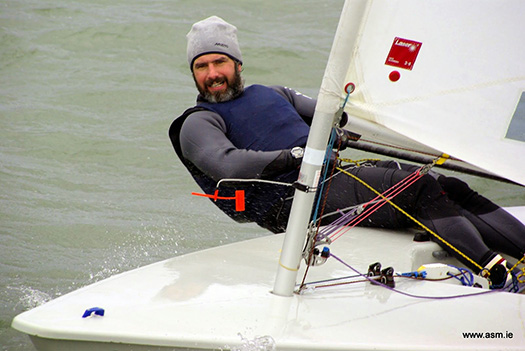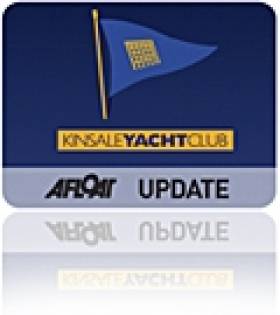Displaying items by tag: ASM
Kinsale Yacht Club Frostbite Series Produces Squib 'Battle Royale'
#kinsalesailing – The forecast for the penultimate day's racing of Kinsale YC's ASM sponsored Frostbite series indicated that there may not be any racing as winds of up to 40 knots were predicted. Many competitors failed to show up as they were convinced that racing would be abandoned.
However race officials managed to get 2 full races underway. The first race started with 12 knots gusting to 17 knots from the South West. Winds increased for the second race, the committee boat measured 16 knots with gusts of 22 knots prior to the start but once the race was underway, gusts rose to 28 knots. The sea was quite calm and fortunately the rain stayed away during racing.
The Lasers raced as one fleet and fresh conditions enabled the solitary Laser Radial sailor (188047 Charlie Moloney) to equally match his full rig counterparts. One of the Full Rig Lasers (161437 Paul Swanton) took a nasty spill in the first race and struck for home.
Once again the Squib fleet produced a battle Royale between club mates Colm Dunne & Rob Gill (Allegro 134), and Colm & Finny O'Regan (Fagin 100). Both had a first and second placing today. Colm & Rob are holding onto their lead of 5 points over Colm and Finny.
The series ends next week...



Kinsale's Frostbite Series in Full Swing (Photos here!)
#KINSALE–Sailing in the annual ASM Marine sponsored Kinsale Yacht Club Frostbite series is underway inside Kinsale Harbour. Brian Carlin captured yestrerday's action (below) in the Squib keelboat and dinghy classes.
The league runs over six Sundays in Late Jaunary and February about sixty sailors will enjoy short sharp races on the Bandon River in underneath Kinsale's famous Charles Fort.
Racing features starts for all singlehanded Laser classes, mixed dinghies and Squibs. Three races are scheduled for each class every weekend. If the full programme is sailed over the six weeks that will see 18 starts for each class.
Entry fees are modest and include mooring and dinghy park space for all competitors.
Strong Winds for Kinsale League
With the Laser Fleets not launching until the last minute, they however mistimed the 11.55 First Gun. After a short postponement, the Squib Class who had been reveling in the pre-start conditions was the first fleet to compete. The strong winds persisted throughout the first race with each squall prompting a flurry of capsizing Lasers as one Squib got into difficulties against the lee shore at Jarley's Cove. As the winds moderated to a force five, with the slackening tide and a calmer sea the remaining two races enjoyed easier if still challenging conditions. The decision to combine the three Laser fleets into one start, and the Squibs with the Mixed Dinghies led to the better management of the last two races given the conditions.
The previously unassailable form of Marcus Hutchinson (KYC) helming 'Sensation', was put under greater pressure in the Squib Fleet, with Victor Fusco and crew James Bendon (KYC) on Gemini notably claiming a first place in the second race. However with his crew Ben Fusco, Marcus took line honours in the other two races bringing his total of wins to five out of a possible six; as two discards now apply. Realistically, with next Sunday being the final day of racing and with eight points behind the leader, Gemini will be hoping to secure the second place overall. With a second in the first race adding to his overall score, he is now just two points ahead of the consistent Colm Dunne and Mark Buckley (KYC) who have moved up a place aided by an excellent second in the third race. Having an unsuccessful day due to a sixth in the first race and not completing the last two, Paul McCarthy (KYC) in Mack drops two places to a fourth overall. On only one point adrift he is still very much in contention for a top three placing.
In the Laser Standard Class Rob Howe (RCYC), though obviously comfortable in the strong breeze, did not quite repeat last week's clean sweep of wins. Nevertheless, with one second and two firsts he retains his overall position in the fleet on seven points overall. David Kenefick (RCYC) took advantage by winning the first race, and his subsequent two seconds puts him on just two points behind the leader going into the final day next Sunday. Having now discarded his worst two scores due to missing the first race day, Paul O' Sullivan (RCYC) continued his consistent form with a further three thirds, and is now in third place overall.
Eoin Keller (LDYC), the previous clear leader in the Laser Radial Class and unable to compete this week, slips dramatically from a total of four points to fifteen points and into second place overall. Eoghan Cudmore (KYC) with a splendid second and two wins on Sunday leaps from third into first place overall. Sean Murphy (KYC) who scored a third and two seconds positions himself just one point behind Keller. With very little between the top three, it will take the remaining races to decide final outcome.
Due to other sailing commitments for the young Laser 4.7 fleet, there has been much changing in the league position over the past few weeks; apart from Cian Byrne (KYC/RCYC) who has resolutely held onto the top position from day one. A close and exciting tussle has finally emerged between Cian and Dara O'Shea (KYC), who despite being on the wrong side of a protest decision in the first race, recovered well to gain a subsequent second and first. He has given himself a chance being well positioned just three points behind overall. Conor Murphy (KYC) with an excellent day's achievement of a first and two seconds has shot up the league table into third place overall.
Brian Jones and Gary Frost (MBSC) in their 505 continued unchallenged with a further three bullets in the Mixed Dinghy Class, with the Fevas of David Marshall/Rob Scandrett and Fiona Lynch/Sofie Kelleher in second and third overall.
The ASM Frostbite League at KYC will be completed next Sunday, 27th February 2011. First Gun is at 11.55 a.m.
Keller Leads Kinsale Radials
With the predicted South-South Westerly winds arriving on schedule for the 11.55 First Gun, PRO Bruce Mathews and team laid a windward- leeward course across the harbour from Money Point to Charles Fort. The moderately difficult conditions, which were dominated by a variable force three to four, were at times exacerbated by persistent gusts sweeping the length of the course. By the end of the first race an unexpected squall left several capsized boats in its wake. With an ebb tide affecting the left side of the course in particular and strengthening as the racing progressed, the competing fleets were challenged with typical Kinsale Frostbite conditions. As five races have now been successfully completed, the first discard in the league series came into play.
First fleet off was the 4.7 Lasers, immediately followed by the combined Laser Radial and Standard rigs, and finally by the combined Squib and Mixed Dinghy classes. The slightly amended running order resulted in a quick and efficient programme which allowed for three races on the day and all crews safely ashore within three hours.
Cian Byrne (KYC/RCYC) although scoring a fourth, a third and a second in the Laser 4.7 races just managed to retain his leading position by a single point. He is closely followed by Darragh O'Sullivan (KYC) a current member of the ISA Laser 4.7 Squad, who scored a first and a fourth, while discarding an unfortunate protest-related penalty from the first week. Dara O'Shea's (KYC) overall third remains secure after scoring a fine first in the first race followed by two fourths. Séafra Guilfoyle (RCYC), another ISA Squad member, turned in the best results of the day as he scored his first points in the series with two seconds and a first in the last race.
Eoin Keller (LDYC) continued his unbeatable form in the Laser Radials, as he completed a clean sweep of all races. His unblemished record of five straight bullets puts him in a commanding position at the head of the fleet. Colm Regan, with two fourths and a second retains second place overall, as Eoghan Cudmore (RCYC/KYC) showing consistent form with two thirds and a second moves up one place to third overall.
In a much depleted Laser Standard fleet this week, Rob Howe (RCYC) took full advantage of the opportunity as he coasted home with three straight wins. His excellent performance moved him up two places to lead the field overall displacing Dave Kenefick (RCYC) who had two seconds on the day.
Marcus and Meagan Hutchinson in 'Sensation' (KYC) convincingly shot to the top of the Squib fleet, from their previous third place with three straight wins as they dominated the day's racing and went on to shake up the leader-board. Previous pace-setter Paul McCarthy in 'Mack' (KYC) having an inconsistent day, slipped down into second overall three points behind as he scored a third, a fourth, and a second in the final race. Also down one place, Victor and Ruth Fusco in 'Gemini' (KYC) scored two fourths and a seventh leaving them four points behind McCarthy. Showing much improved form, Colm Dunne and Mark Buckley (KYC) had a very successful day with a second and two thirds and moved up several places to take fourth overall.
In the Mixed Dinghy Fleet, the 505 of Brian Jones and Gary Frost (MBSC) lead the David Marshall and Rob Scandrett owned Feva (RCYC), followed by Fiona Lynch's Feva and Shane Dwyer's Topaz Uno Plus. Individual results were not available at the time of writing.
The ASM Frostbite League at KYC continues over the next two Sundays, finishing on 27th February 2011. The Sailing Instructions allow for twelve races to complete the series, with a possible three discards to apply. First Gun is at 11.55 a.m.
































































